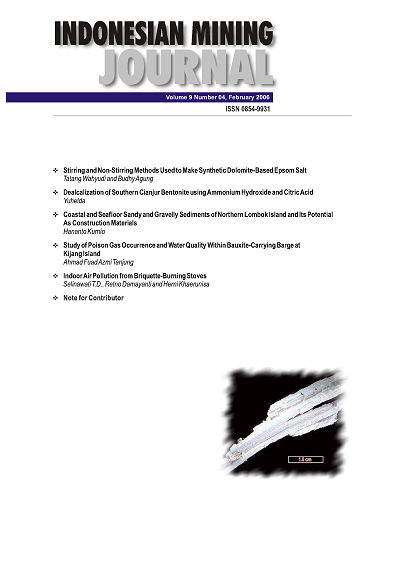STIRRING AND NON-STIRRING METHODS USED TO MAKE SYNTHETIC DOLOMITE-BASED EPSOM SALT
DOI:
https://doi.org/10.30556/imj.Vol9.No1.2006.654Keywords:
STIRRING AND NON-STIRRING METHODS USED TO MAKE SYNTHETIC DOLOMITE-BASED EPSOM SALTAbstract
The increasing need of magnesium sulfate heptahidrat by various industries and the limited availabil- ity of this material in nature are two reasons to produce MgSO4.7H2O synthetically. Basically, such a material can be produced from dolomite. A laboratory scale of dolomite-based epsomite making which employed two crystallization processes was conducted. Those were stirring and non-stirring methods and the results showed that stirring one yielded 98.2312 to 98.7244 % MgSO4.7H2O salt. The non-stirring method produced salts of 97.5929 – 99.0378%. Yet prior to salt processing, magne- sium sulfate solution was evaporated at 100 – 110°C to get solution densities around 1.35, 1.38 and
1.4 g/ml. The bigger the density the bigger the MgO and SO3 contents
References
Agung, Budhy et al. 2000. “Pemanfaatan Pilot Plant Dolomit untuk Pembuatan Pupuk Kieserite Gresik, Jawa Timur”. Laporan Teknik Pengolahan No, 174, Pusat Penelitian dan Pengembangan Teknologi Mineral, Direktorat Jenderal Pertambangan Umum, Bandung.
Anon., 1970. Encyclopedia Britannica. v. 8. A So- ciety of Gentlemen in Scotland: William Benton Publisher.
Halsey, D., 1974. William Coulter’s Encyclopedia. v 15. McMillan Educational Corporation, USA.
Kirk-Othmer, 1995. Encyclopedia of Chemical Technology. v 15. 4th Ed. New York: John Wiley & Sons.
Oss, J. F. van, 1968. Material and Technology. v
London: Longmans.
Partington, 1957. General and Inorganic Chemis- try. 3rd Ed., McMillan.
Soin, Taito O and Charles O Wilson, 1963. Roger’s Inorganic Pharmaceutical Chemistry. 7th Ed. Philadelphia: Lea and Fibiger Publisher.
Taylor, S.F., 1960. Inorganic Theoretical Chemis- try. 10th Ed. London: Heinemann.
Weissman, J., 2006. Epsomite. Webpage in webmineral.com. Browsed at 8.00 am, 30
January 2006.
Downloads
Issue
Section
License
Indonesian Mining Journal provides immediate open access to its content on the principle that making research freely available to the public to supports a greater global exchange of knowledge.

This work is licensed under a Creative Commons Attribution-NonCommercial 4.0 International License.













